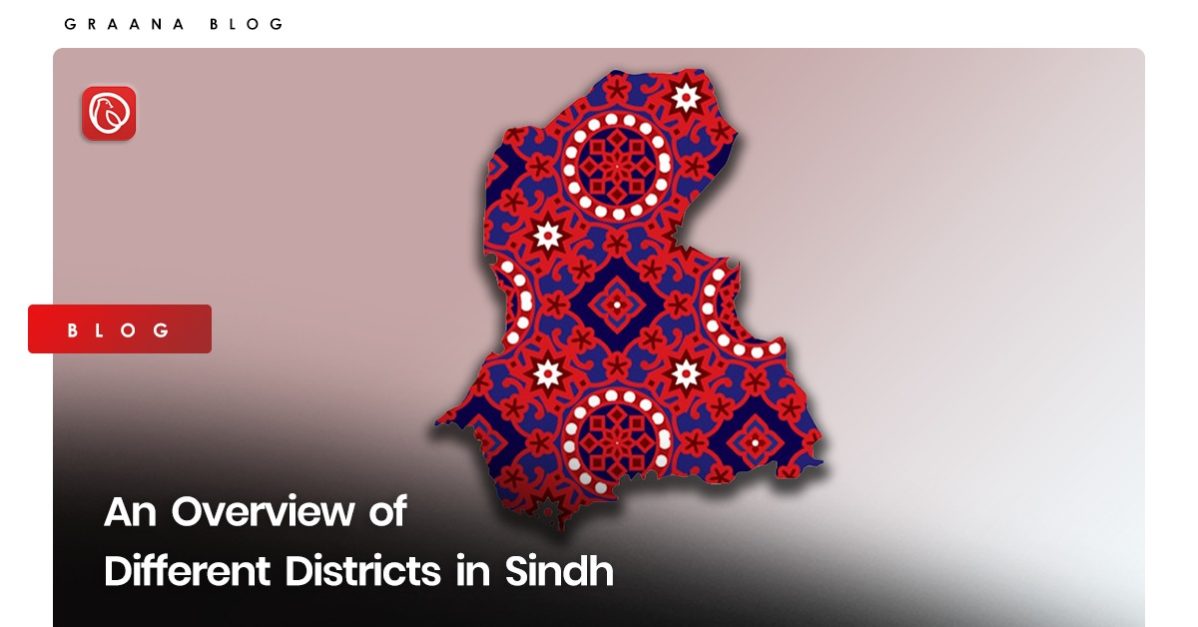Sindh is a province with a rich history and diverse population. It is divided into 7 divisions and 30 districts, each with its unique features, tourist attractions and traditions. Graana.com provides a detailed overview of some of the most significant districts in Sindh below.
Historical Background of District in Sindh
Sindh has been a centre of civilisation for thousands of years, with an extensive history that dates back to the Indus Valley Civilization. The district system in Sindh was established during the British colonial era, and the district boundaries have undergone several changes since then.
Lists of Districts in Sindh
Sindh has 30 districts, including Karachi, Hyderabad, Sukkur, Larkana, and Khairpur. The complete list of districts in Sindh is given in the table below.
| Sr. No. | District | Headquarters | Area (km2) | Population (2017) | Division |
| 1 | Badin | Badin | 6,858 | 1,804,958 | Banbhore |
| 2 | Dadu | Dadu | 7,866 | 1,550,390 | Hyderabad |
| 3 | Ghotki | Ghotki | 6,083 | 1,648,708 | Sukkur |
| 4 | Hyderabad | Hyderabad | 993 | 2,199,928 | Hyderabad |
| 5 | Jacobabad | Jacobabad | 2,698 | 1,007,009 | Larkana |
| 6 | Jamshoro | Jamshoro | 11,204 | 993,908 | Hyderabad |
| 7 | Karachi Central | North Nazimabad | 69 | 2,971,382 | Karachi |
| 8 | Karachi East | Gulshan-e-Iqbal | 139 | 2,875,315 | Karachi |
| 9 | Karachi South | Saddar | 122 | 1,769,230 | Karachi |
| 10 | Karachi West | Orangi Town | 370 | 2,077,228 | Karachi |
| 11 | Kashmore (formerly Kandhkot) | Kashmore | 2,580 | 1,090,336 | Larkana |
| 12 | Keamari | Mariro Mirbahar (Site) | 559 | 1,829,837 | Karachi |
| 13 | Khairpur | Khairpur | 15,910 | 2,405,190 | Sukkur |
| 14 | Korangi | Korangi Town | 108 | 2,577,556 | Karachi |
| 15 | Larkana | Larkana | 1,948 | 1,521,786 | Larkana |
| 16 | Malir | Malir Town | 2,160 | 1,924,346 | Karachi |
| 17 | Matiari | Matiari | 1,417 | 770,040 | Hyderabad |
| 18 | Mirpur Khas | Mirpur Khas | 2,925 | 1,504,440 | Mirpur Khas |
| 19 | Naushahro Feroze | Naushahro Feroze | 2,946 | 1,612,047 | Shaheed Benazir Abad |
| 20 | Qambar Shahdadkot | Qambar | 5,475 | 1,338,035 | Larkana |
| 21 | Sanghar | Sanghar | 10,728 | 2,049,873 | Shaheed Benazir Abad |
| 22 | Shaheed Benazirabad (formerly Nawabshah) | Nawabshah | 4,502 | 1,613,506 | Shaheed Benazir Abad |
| 23 | Shikarpur | Shikarpur | 2,512 | 1,233,760 | Larkana |
| 24 | Sujawal | Sujawal | 8,785 | 779,062 | Banbhore |
| 25 | Sukkur | Sukkur | 5,165 | 1,488,372 | Sukkur |
| 26 | Tando Allahyar | Tando Allahyar | 1,554 | 838,527 | Hyderabad |
| 27 | Tando Muhammad Khan | Tando Muhammad Khan | 1,423 | 677,098 | Hyderabad |
| 28 | Tharparkar | Mithi | 19,637 | 1,647,036 | Mirpur Khas |
| 29 | Thatta | Thatta | 8,570 | 982,138 | Banbhore |
| 30 | Umerkot | Umerkot | 5,608 | 1,073,469 | Mirpur Khas |
Larkana District
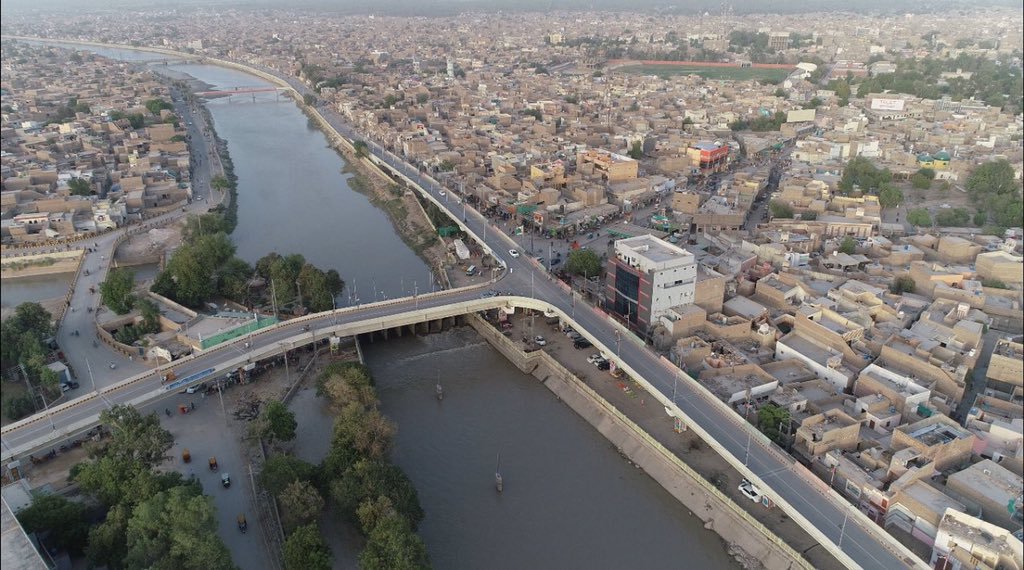
The Larkana district is well-known for being the home district of the influential Bhutto family. The district’s primary city, Larkana, is situated along the banks of the Indus River, while other notable towns in the area include Ratodero, Dokri, Bakrani, and Naudero.
The district was established on August 1, 1901, through the amalgamation of the Karachi and Shikarpur districts. The Sehwan, Johi, and Dadu talukas were obtained from the Karachi district, while the Mehar, Kakar, Warah, Larkana, Labe Darya, Kambar, and Ratodero talukas were acquired from Shikarpur District, which is now known as Sukkur District.
This merger led to the formation of three divisions: the Sehwan division comprising Sehwan, Johi, and Dadu talukas; the Mehar division comprising Mehar, Kakar, and Warah talukas; and the Larkana division comprising Larkana, Labe Darya, Kambar, and Ratodero talukas.
In 2005, the Government of Pakistan, under the leadership of Pervez Musharraf, decided to bifurcate the district, creating a new district called Qamber and Shahdadkot.
Sukkur District
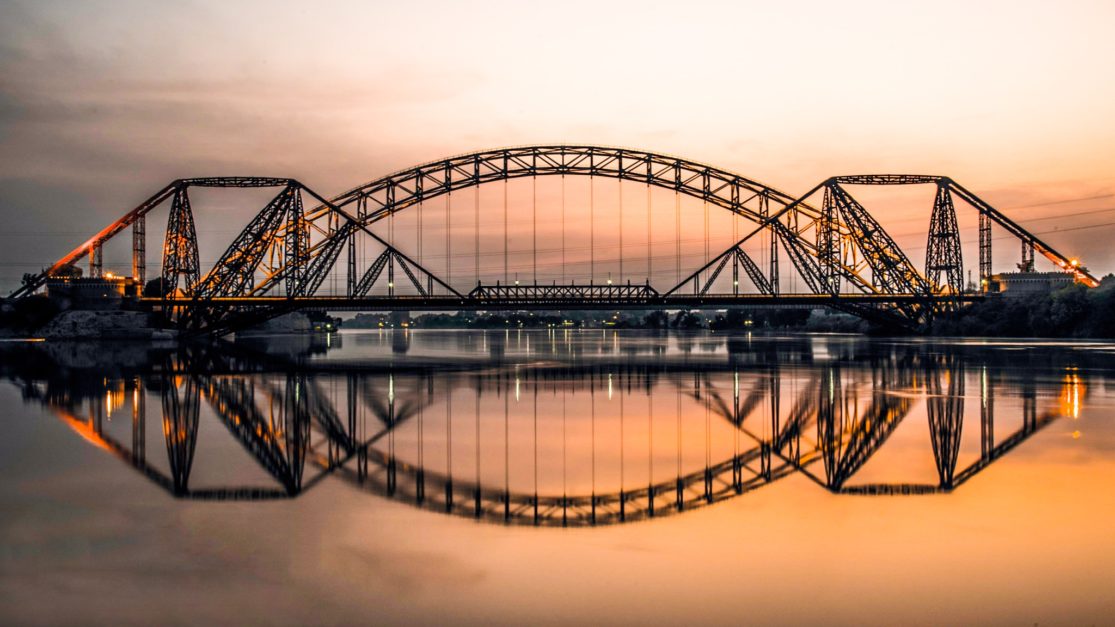
The Sukkur district comprises five administrative townships, locally referred to as “talukas” or “tehsils”. These include Sukkur City, New Sukkur, Rohri, Saleh Pat, and Pano Aqil.
While Sukkur City and New Sukkur are urban centres, Pano Aqil is known for hosting one of the largest military cantonments in the country. Rohri, although the smallest in terms of both area and population, boasts an essential railway junction.
Over time, the territory of Sukkur District has been divided, and two new districts have been formed. Shikarpur became a separate district in 1977, while Ghotki was established as a district in 1993.
Hyderabad District
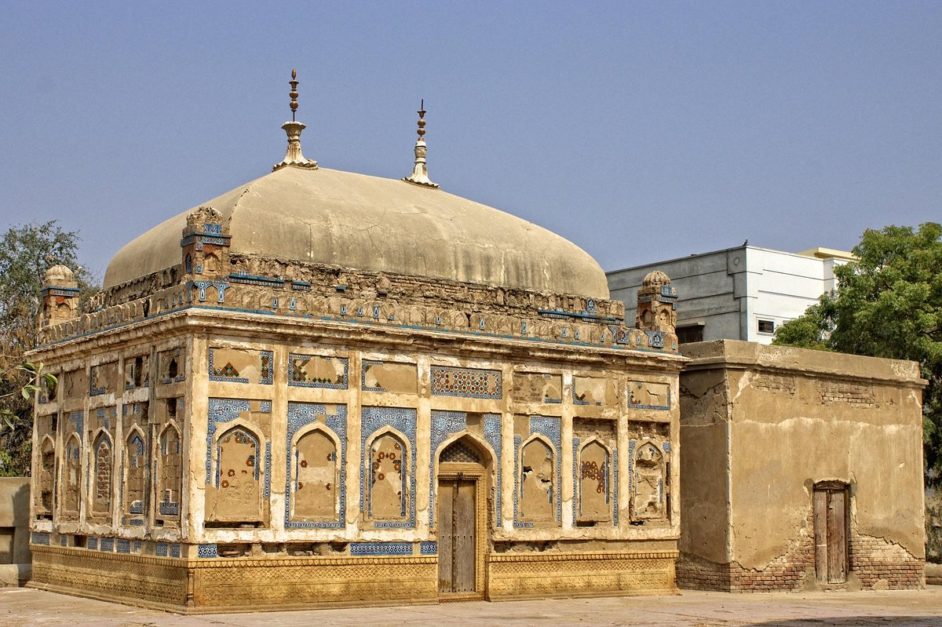
This is the second most urbanised district in Sindh after Karachi, with approximately 80% of its residents living in urban areas. The Hyderabad district has undergone several administrative changes throughout its history.
When Sindh was occupied by the East India Company in 1843, Hyderabad was one of the three districts established in the province, along with Karachi and Shikarpur (now Sukkur district). In 1912, the northern part of the district was separated to form the Nawabshah district and, in 1975, the southern part was separated to create the Badin district.
In 1982, the eastern part of the district was bifurcated to create the Thar and Parkar district, which now has its headquarters in Umerkot. Two new talukas were added to the district in 1998 – Hyderabad city and Latifabad talukas – and, after the 2002 elections, another taluka was created named Qasimabad from Hyderabad City taluka.
The district headquarters were located in the city of Hyderabad until the early 1970s, and the district government used to operate from there as well.
However, former president Pervez Musharraf introduced a local body government in 2001 that abolished this administrative setup. In 2005, three new districts – Tando Muhammad Khan, Matiari, and Tando Allahyar districts – were created from the Hyderabad district.
Karachi Central District
The district of Central Karachi, also known as Karachi Central, is an administrative district located in the Karachi Division of Sindh. It was previously abolished in the year 2000, and four towns were created as its subdivisions.
These included Liaquatabad Town, North Nazimabad Town, Gulberg Town, and New Karachi Town. However, on 11 July 2011, the Sindh Government restored the district of Karachi Central again.
As of 2022, the district has been further divided into five towns, which include Liaquatabad Town, North Nazimabad Town, Gulberg Town, New Karachi Town, and Nazimabad Town.
Additionally, the district encompasses the dehs (administrative subdivisions) of Gujhro (P), which are located in the talukas (subdivisions) of Liaquatabad and Gulberg, and Kari Lakhi, which is located in the taluka of North Nazimabad.
Karachi East District
The Karachi East district, which falls under the administration of Karachi Division in Sindh, has a long and diverse history. It was initially established in 1972, but later abolished in 2000.
Following its abolition, the district was divided into four separate towns: Gulshan Town, Jamshed Town, Gulzar-e-Hijri Town, and Faisal Cantonment, with Firozabad Town becoming a part of the Karachi West district.
On 11 July 2015, the Sindh government decided to restore the Karachi East district again. Following this restoration, three eastern towns of Karachi East district separated from the district in November 2013 to form a new district named Korangi.
In addition, Jamshed Town of the Karachi South district was added to the Karachi East district. It now comprises two towns: Jamshed and Gulshan.
Recently, in 2022, the Karachi East district was restructured and divided into five towns: Sohrab Goth Town, Safoora Town, Gulshan Town, Jinnah Town, and Chanesar Town. With this restructuring, the district now has 43 union councils and 172 wards.
The division has brought positive changes to the district, and the new towns and wards have improved the management of the region while also facilitating better governance for the residents.
Karachi South District
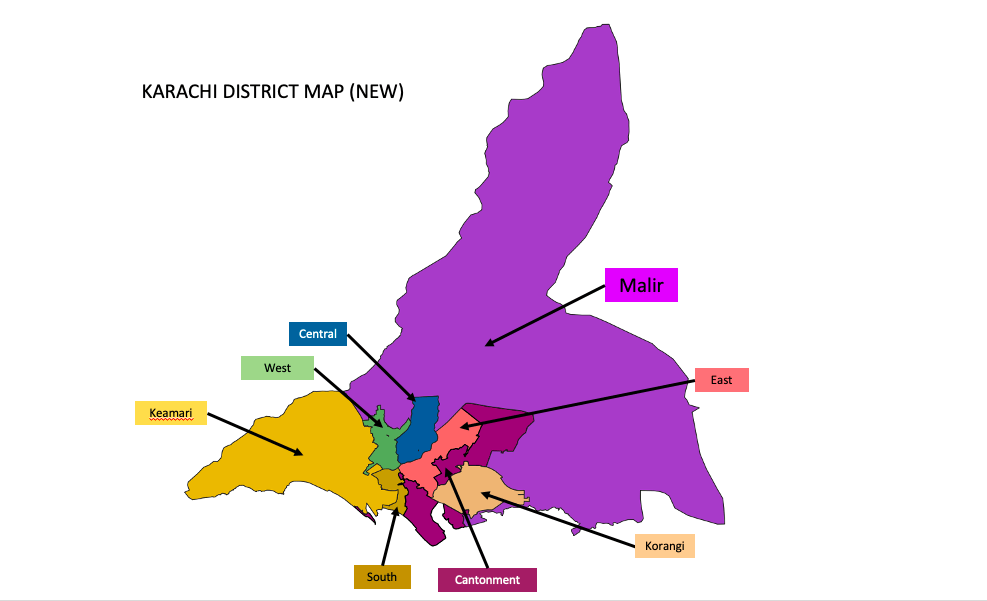
The Karachi South district is the financial hub of the country. It houses the head offices of numerous corporations, banks, and companies, along with important government offices such as the Chief Secretary House, Governor House, Chief Minister House, Commissioner House, Commissioner Office, Sindh Assembly, Sindh High Court, embassies and consulates of different countries.
The district was abolished in 2000 and divided into two towns, namely Jamshed Town and Saddar Town. However, the Sindh government restored the Karachi South district on 11 July 2011.
In November 2013, Jamshed Town was incorporated into the Karachi East district after three eastern towns were split up to form a new district named Korangi. Currently, Karachi South comprises Saddar, Clifton, and the Defence area, and is widely regarded as the most affluent area of the city.
Karachi West District
The Karachi West district in Sindh is an administrative district of the Karachi Division. It was abolished in 2000 but was later restored by the Sindh government on 11 July 2011. It was originally divided into five towns, namely Lyari Town, Kemari Town, SITE Town, Baldia Town, and Orangi Town.
In 2020, Kemari Town, SITE Town, and Baldia Town were separated from the district to become a part of the Kemari district. In 2015, Lyari became a part of the Karachi South district.
The population of the district is diverse, which includes Sindhis, Balochis, Punjabis, Pashtuns, and Muhajirs, and no single ethnic group forms a majority in the district.
Badin District
The Badin district covers a total area of 6,726 square kilometres of Sindh. It shares borders with the Tando Allahyar district to the north, Hyderabad district to the northwest, Mirpur Khas and Tharparkar districts to the east, Kutch district of India to the south, and Sujawal and Tando Muhammad Khan district to the west.
It is centred around the city of Badin, which has a rich history dating back to the ancient Indus Valley civilisation. The region came under Islamic rule in 711 CE and was subsequently ruled by the Ghaznavids and Mughal emperors.
Conclusion
The districts of Sindh are important in terms of governance, development, and representation. Each has its elected officials and administrative structures responsible for the welfare and development of the people.
To know about the districts of other provinces, visit Graana blog.
